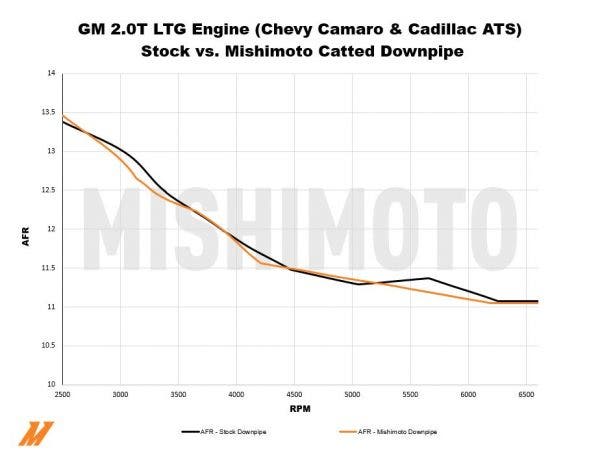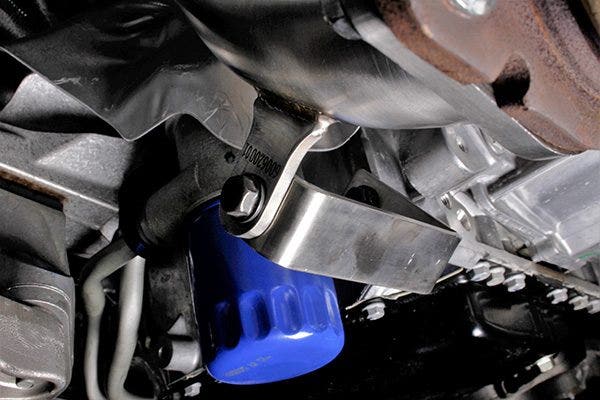
The Rise to Power - Downpipe R&D, Part 2: A Working Prototype
Downpipes are a choke point in many turbocharged vehicles when it comes to exhaust flow. As opposed to naturally aspirated cars, less serious thought needs to go into the size of the exhaust piping. In most cases the system just needs to be bigger in diameter, maximizing what you can within the alotted design space.
The downpipe on the Camaro 2.0T's LTG engine is a restrictive point in the exhaust system, a conclusion brought about by our testing. The point of emphasis is the rate at which exhaust gases are expelled out of the turbocharger. That flow is very important to how well the turbocharger can do its job. If you can flow more exhaust gases, the turbine can spin faster, leading to more boost. It is now time to test the prototype and figure out what our downpipe design can do for this LTG power-plant.

Production sample of our downpipe!
There is a noticeable difference in sound. Even with our catback and intake on the car, you can hear a much throatier and raspier exhaust sound. This can be considered as an indication of how restrictive the stock downpipe is. The stock downpipe has an inner diameter of three inches at the turbo, but necks down to 2.25 inches. Our downpipe is 3 inches all the way through, opening up the flow and eliminating the restriction from the turbocharger's exhaust gases.

Camaro 2.0T downpipe Dyno run results
Consistent performance gains were extracted from this downpipe with max gains averaging 7hp and 10 ft-lbs of torque, making it a performance modification that you can feel when you get on the throttle.

AFR results
Although the air-fuel ratio results make this downpipe perfectly safe to run on your stock LTG setup, it is important to talk about the catalytic converter. While this downpipe includes a catalytic converter, it is a smaller, high-flow version, so restriction is minimized. However, this comes with caution. Since this is a high flow converter, it will cause a Check Engine light to be appear on your dashboard as it did on our Camaro. This is due to the catalytic cell count within the converter being lower than stock. We safely ran the car for quite some time without a tune, but we cannot recommend that you do the same. Therefore, it is strongly recommended that this part be for off-road use only and paired with a tune from a professional tuner.
Fitment

Our downpipe installed on our Camaro 2.0T
This downpipe is substantially lighter than the stock unit. It surprised me when I held the two together. The stock unit weighs in at 17.2 lbs. That is pretty heavy considering the small overall size of the downpipe. Our downpipe nearly halves that with a weight of 9.6 lbs. So not only are you getting a power increase, but your application will also lose a bit of weight.

An engine bay view of the downpipe on our 2.0T

A shot of the bracket for the 2.0T
The same holds true for the 2013+ Cadillac ATS 2.0T. Each application gets to reap the benefits of both the weight loss and power gains since the downpipe is a direct fit for both. The chassis are similar enough for us to make a pipe that fits both cars, so you guys aren't left out. While all testing was done on our shop Camaro 2.0T, we have compared the results to the expected performance of this part on a Cadillac ATS 2.0T and have determined that there would be no measurable difference. See below for some installed shots on a loaned ATS.

Clears the firewall!

A shot of the bracket for the ATS
The brackets are different for both cars, so each kit will come with a bracket of our design. Those of you with the ATS will not need it, but for this to bolt properly on Camaro 2.0T's, you will.
With the completion of this prototype design and successful dyno testing, it's time to wrap this project up. We are close to making the presale live. During that time, you will be able to preorder this part at a substantial mark-down from MSRP. Stay tuned for that, and thanks for following along!

-Diamaan




